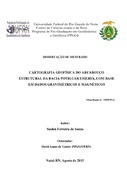Use este identificador para citar ou linkar para este item:
https://repositorio.ufrn.br/handle/123456789/20452| Título: | Cartografia geofísica do arcabouço estrutural da bacia potiguar emersa, com base em dados gravimétricos e magnéticos |
| Autor(es): | Souza, Suelen Ferreira de |
| Orientador: | Castro, David Lopes de |
| Palavras-chave: | Expressão gravimétrica;Expressão magnética;Bacia potiguar;Estruturas tectônicas |
| Data do documento: | 12-Ago-2015 |
| Editor: | Universidade Federal do Rio Grande do Norte |
| Referência: | SOUZA, Suelen Ferreira de. Cartografia geofísica do arcabouço estrutural da bacia potiguar emersa, com base em dados gravimétricos e magnéticos. 2015. 96f. Dissertação (Mestrado em Geodinâmica e Geofísica) - Centro de Ciências Exatas e da Terra, Universidade Federal do Rio Grande do Norte, Natal, 2015. |
| Resumo: | O estudo de bacias sedimentares envolve uma integração de informações adquiridas a partir da aplicação de diversas metodologias. Os métodos potenciais, gravimétrico e magnético, representam uma metodologia eficaz no estudo do arcabouço tectônico de bacias sedimentares a um custo relativamente barato, se comparado às demais técnicas. O presente trabalho apresenta a integração de diferentes técnicas avançadas de processamento geofísico em dados potenciais (Redução ao Polo, Matched Filter, Gradiente Horizontal e Inclinação do Sinal Analítico), que auxiliaram grandemente na particularização da expressão geofísica das principais componentes estruturais do Rifte Potiguar e seu embasamento cristalino. Os resultados permitiram identificar claramente as bordas falhadas do Rifte Potiguar (Carnaubais, Apodi e Mulungu), assim como seus componentes internos, horsts Macau e Quixaba, e os grabens Apodi, Umbuzeiro e Boa Vista. As expressivas zonas de cisalhamentos do seu embasamento (Senador Pompeu, Jaguaribe, Portalegre, Açu, Florânia-Ângicos e Picuí João-Câmara) também foram evidenciadas pelo mapeamento geofísico como extensos alinhamentos sigmoidais de direção NE-SW. A integração dos dados geofísicos com dados geológicos permitiu a identificação de oito domínios tectôno-geofísicos com o objetivo de se estabelecer o comportamento dos principais blocos crustais da Província Borborema abaixo do pacote sedimentar. As respostas fornecidas pelas técnicas permitiram ainda a associação das estruturas acima citadas com as principais etapas de rifteamento pelos quais passou a bacia durante a sua complexa evolução. O trend NE-SW, que ocorre como o principal padrão direcional nas regiões adjacentes ao Rifte Potiguar e também em seu interior, evidencia uma forte influência de estruturas pré-cambrianas na formação da bacia, assim como a deformação NW-SE nos diques Rio Ceará-Mirim, o truncamento de estruturas NE com a Falha de Apodi, e também o afastamento entre a Zona de Cisalhamento Portalegre e o Sistema de Falhas de Carnaubais, contribuem para hipótese de propagação dos esforços da Margem Equatorial para o interior do continente. |
| Abstract: | The study of sedimentary basins involves an integration of information acquired from the application of different methodologies. The Potential Methods, gravity and magnetic represent an effective methodology to study the tectonic framework of sedimentary basins, at a relatively cheap cost than another techniques. The present work presents the integration of different advanced techniques of geophysical processing in potential data (Reducing to Pole, Matched Filter, Horizontal Gradient and Tilt Derivative) which greatly assisted in characterization of geophysical expression of the main structural components of Potiguar Rift and it tectonic framework. The results allowed clearly identify the failed edges of the Potiguar Rift (Carnaubais, Apodi e Mulungu faults), as well as its internal components, Macau and Quixaba horsts, and the Apodi, Umbuzeiro and Boa Vista grabens. The expressive shear zones of it basement (Senador Pompeu, Jaguaribe, Portalegre, Açu, Florânia-Ângicos e Picuí João-Câmara) they also were evidenced by geophysical mapping as extensive sigmoidal alignments of NE-SW direction. The integration of geophysical data with geological data allowed the identification of eight tectonic geophysicist domains, with purpose of establishing the behavior of main crustal blocks of the Borborema Province bellow of the sedimentary package. The results provided by techniques also allowed the association of the above mentioned structures with the main stages of rifting by which passed the basin during its complex evolution. The trend NE-SW, that occurs as the main directional pattern in the adjacent regions to the Potiguar Rift, and also inside evidence a strong control of precambrian structures in basin formation, as well as the NW-SE deformation in the Rio Ceará-Mirim dykes swarms, the truncation of NE structures with Apodi Fault, and also the separation between Portalegre Shear Zone and the Carnaubais System Faults, contribute to the hypothesis of propagation of the Equatorial Margin efforts into the continent. |
| URI: | https://repositorio.ufrn.br/jspui/handle/123456789/20452 |
| Aparece nas coleções: | PPGG - Mestrado em Geodinâmica e Geofísica |
Arquivos associados a este item:
| Arquivo | Descrição | Tamanho | Formato | |
|---|---|---|---|---|
| SuelenFerreiraDeSouza_DISSERT.pdf | 7,34 MB | Adobe PDF |  Visualizar/Abrir |
Os itens no repositório estão protegidos por copyright, com todos os direitos reservados, salvo quando é indicado o contrário.

